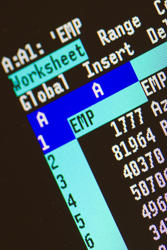You probably already know that Excel will easily open a wide variety of spreadsheets stored in other formats. One that it will open is spreadsheets originally created in Lotus 1-2-3. If you have some old 1-2-3 files and you want to make sure that they are treated, in Excel, according to Lotus 1-2-3 'rules,' there are a couple of settings you need to pay attention to. These settings are available from the Options dialog box. (See Figure 1.) Choose Options from the Tools menu to display this dialog box.
Lotus 1-2-3, the computer software program that was the spreadsheet of choice for businesses in the 1980s, was born in the Boston area on January 26, 1983. It was the brainchild of Mitch Kapor and Jonathan Sachs who had formed Lotus Development Corp. To release the software program. The Lotus Development Corporation was founded by Mitchell Kapor, a friend of the developers of VisiCalc. 1-2-3 was originally written by Jonathan Sachs, who had written two spreadsheet programs previously while working at Concentric Data Systems, Inc. To aid its growth, in the UK, and possibly elsewhere, Lotus 1-2-3 was the very first computer software.
Figure 1. The Transition tab of the Options dialog box.
Make sure the Transition tab is displayed. Notice the two options under Sheet Options; these are what you need to work with:

- Transition Formula Evaluation. When checked, this option causes Excel to open and evaluate 1-2-3 files without losing or changing information. Based on the formulas in the 1-2-3 file, if this option isn't checked, then you might lose some data or some formulas won't calculate the same in Excel as they would have in Lotus 1-2-3. Specifically, with this option selected Excel evaluates text strings as 0 (zero), Boolean expressions as 0 or 1, and database criteria according to the rules used in Lotus 1-2-3.
- Transition Formula Entry. If this check box is selected, then formulas entered in Lotus 1-2-3 version 2.2 syntax are converted to Excel syntax. This option should not be selected if you don't plan on saving the spreadsheet in Excel format.
Make your settings, as desired, then close the Options dialog box. Open the Lotus 1-2-3 spreadsheet and Excel should process the file according to the settings you made.
Companies & Industries
Once the world's most important piece of business software, it suffered a long decline
Lotus 1-2-3, the computer software program that was the Ergo proxy torrent download. spreadsheet of choice for businesses in the 1980s, was born in the Boston area on January 26, 1983. It was the brainchild of Mitch Kapor and Jonathan Sachs whohad formedLotus Development Corp.to release the software program. The two weren’t new to computer spreadsheets: Kapor was the head of development at VisiCorp, which marketed the first desktop spreadsheet program, VisiCalc, and Sachs was a computer programmer who had been transferring VisiCalc to some of the world’s first minicomputers.

Before Lotus 1-2-3, VisiCalc, which was designed for Apple II computers in 1979, dominated the desktop spreadsheet market. But IBM started running Kapor’s and Sachs’s spreadsheet program on its computers, and companies couldn’t get enough of it. They started purchasing IBM computers in droves just to get their hands on the software that combined spreadsheets, a graphics package and an early-stage database manager into one. Computer games free download for windows 7 32 bit cricket.
MORE: The Ode: Sony Walkman (1979 – 2010) »
The launch of Lotus 1-2-3 had disrupted the monopoly VisiCorp’s spreadsheet program was enjoying, and had set the standard for productivity applications on personal computers. By October 1983, Lotus 1-2-3 was reportedly outselling VisiCalc.
Under Kapor’s leadership Lotus Development Corp.started adding new products under its belt.in 1985, but none performed as well as the popularshining star Lotus 1-2-3. That same year, Lotus bought VisiCalc, discontinued it, and offered its customers Lotus 1-2-3 upgrades instead.
But by 1986, Lotus 1-2-3 was getting neglected when Kapor stepped down as president and CEO of the company and handed the mantle to Jim Manzi. Manzi was focusing his attention and resources away from the company’s first success and looking for its next up-and-comer. It was around this time that Bill Gates was creating his own version of a desktop spreadsheet program, and slowly Excel and Microsoft’s Office encroached on Lotus 1-2-3’s turf. By the early 1990s, Lotus 1-2-3’s position at the head of the class was usurped definitively by Microsoft Excel.
By the time IBM bought Lotus Development Corp. in July 1995 for $3.5 billion, Lotus 1-2-3 was on life support. Lotus 1-2-3’s cousin, Lotus Notes—which offered companies integrated messaging, business applications and social collaboration in one workspace—was the program that caught IBM’s eye; Lotus 1-2-3 simply tagged along because it was family.
MORE: How Windows XP became the operating system that just won’t die »
But even with IBM attempting to breathe new life into Lotus Development’s products, Lotus 1-2-3, once the backbone for businesses’ office productivity, couldn’t be resuscitated. IBM continued to develop Lotus’s groupware product portfolio, and packaged Lotus 1-2-3 with its suite of Lotus programs, but the spreadsheet program was already on the chopping block.

In 2012, IBM slowly started removing Lotus branding and wound downsections of the groupware portfolio. In May 2013, IBM announced that it would no longer support Lotus 1-2-3, along with Lotus Organizer and Lotus SmartSuite. IBM told users that they had until September 2014 to get their papers in order. On September 30, IBM pulled the plug on Lotus 1-2-3. The spreadsheet program that was once the world’s most important productivity application finally went dark.
Watch this 1983 promotional video for Lotus 1-2-3:
What Was Before Lotus 123

